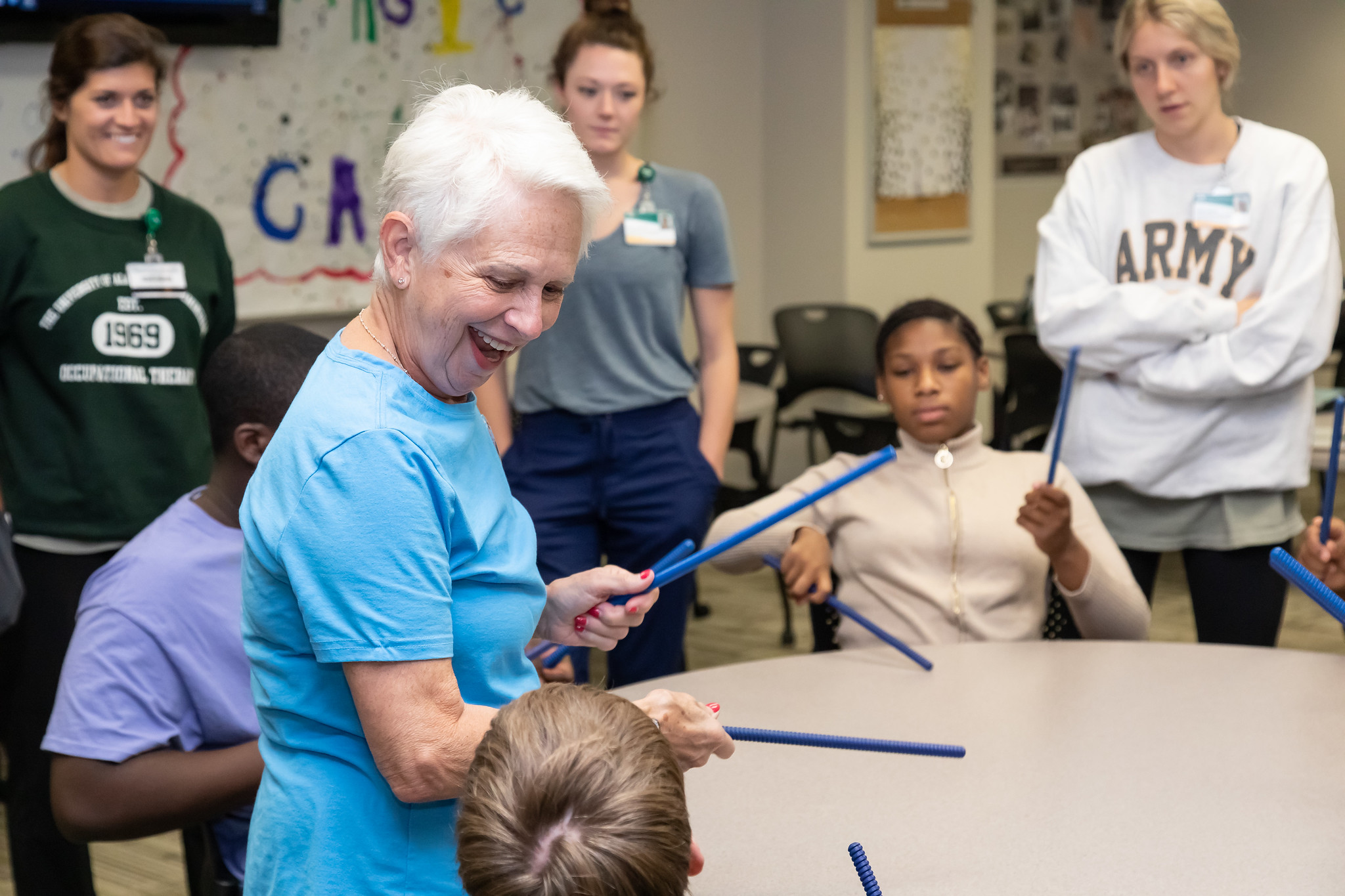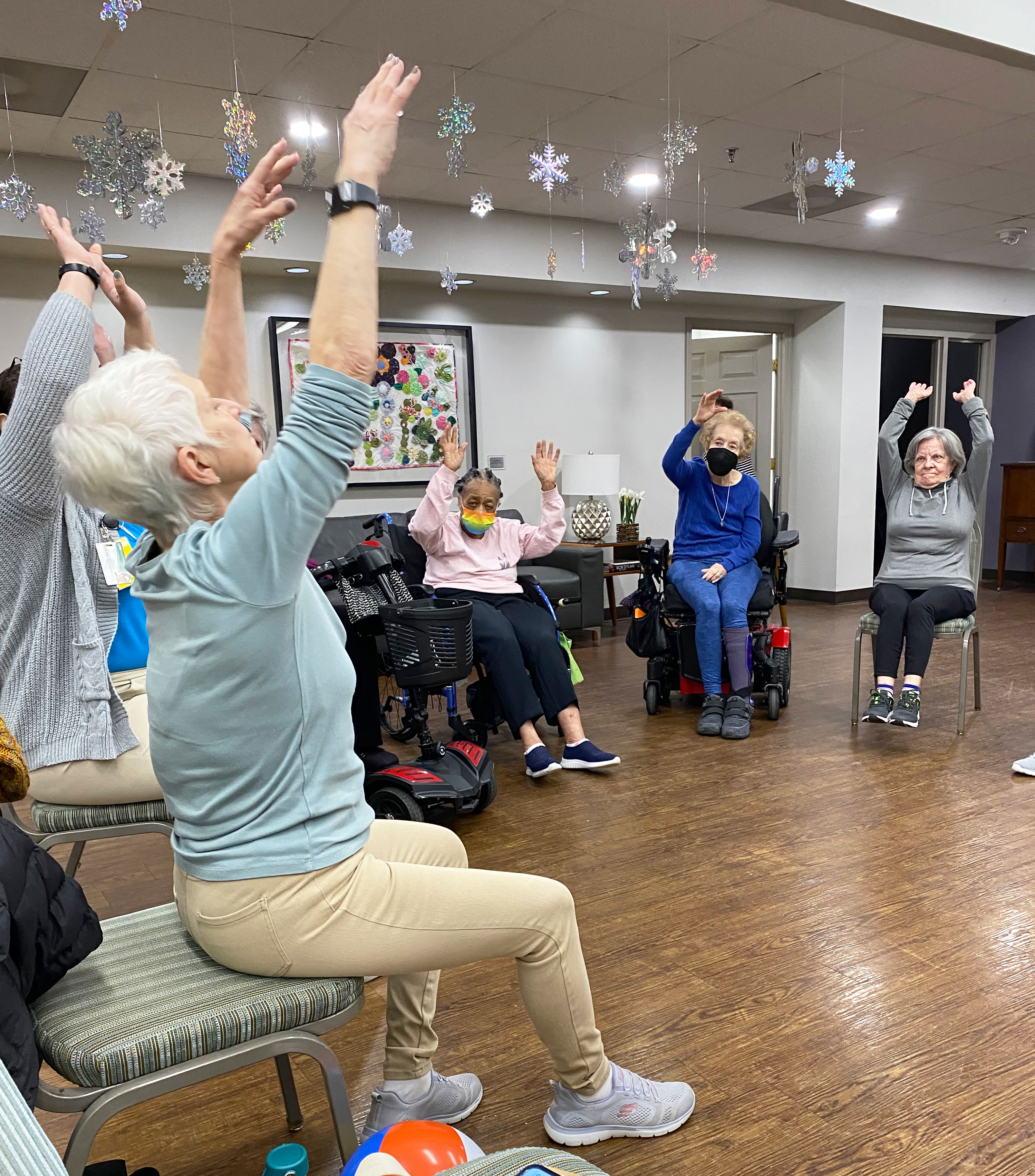 During an annual Magic Camp for disabled children, Arts in Medicine artist-in-residence Melissa Turnage works with occupational therapy students and campers.When dancer and dance teacher Melissa Turnage walks into a room, she can spot the people who do not want to dance — their body language gives them away.
During an annual Magic Camp for disabled children, Arts in Medicine artist-in-residence Melissa Turnage works with occupational therapy students and campers.When dancer and dance teacher Melissa Turnage walks into a room, she can spot the people who do not want to dance — their body language gives them away.
But Turnage, a charismatic “ambassador” for movement and posture who has been dancing all her life, does not give up easily. Give her a few minutes, and everyone in the room will be moving.
“Dance is our birthright,” Turner said. “Human bodies are made to move. There is something magical about it, but also scientific: The endorphins rise, making you feel better. Certain areas of the brain light up near your happiness zone when you are dancing, and there is just this physiological, wonderful energy that happens when you allow yourself to just dance.”
Turnage, who has taught dance for 50 years, is an artist-in-residence in the University of Alabama at Birmingham’s Arts in Medicine program. Turnage’s mother was a dance teacher, and her father was a doctor who did his residency at UAB.
She leads classes for adolescent and geriatric patients in the UAB Medicine Center for Psychiatric Medicine and for those in addiction recovery, works with occupational therapy students in the School of Health Professions, and meets weekly with residents of a nearby residential home for seniors. Turnage also works with staff, leading everything from dance days to flash mobs, including social workers, those caring for patients with psychiatric issues and head and neck cancers at UAB, and those caring for patients at Children’s of Alabama. She has worked with veterans and those with dementia, plus guided toddlers and young children in dance and movement and adults in ballet through UAB’s ArtPlay Community Education.
On Sept. 22, veterans and their families can come to the Birmingham VA for veterans’ dance circle day and hop into Turnage’s dance circle for a few minutes of dance with fun music, she says. More pop-up dance circles on the UAB campus are in the works.
Through AIM, she wrote a research paper published in Aging Medicine and Healthcare documenting the mental and physical benefits of teaching ballet to seniors in low-income housing. In 2019, she was honored with a UAB Excellence in Medicine award.
Turnage says it is an incredible joy for her to see what happens when people start moving, and the excitement, laughter and creativity people can come up with. She can walk into a room of depressed children, lethargic in their bodies, give them a scarf and everything changes. Scarves are one of the tools she uses in her dance kit.
 Turnage leads a weekly UAB Arts in Medicine dance and movement class for residents of Episcopal Place, which offers housing and independent living for seniors and adults with disabilities.“I really do see the worth, and my patients will tell me, ‘Wow, I feel so much better,’” she said. “Even those who are resistant to trying. Especially with the teenagers in CPM, I hear, ‘I don’t dance’ and ‘I have no rhythm.’ And so, my comeback to that is, if you have a heartbeat, you have got rhythm. That is your personal rhythm; get in touch with it.”
Turnage leads a weekly UAB Arts in Medicine dance and movement class for residents of Episcopal Place, which offers housing and independent living for seniors and adults with disabilities.“I really do see the worth, and my patients will tell me, ‘Wow, I feel so much better,’” she said. “Even those who are resistant to trying. Especially with the teenagers in CPM, I hear, ‘I don’t dance’ and ‘I have no rhythm.’ And so, my comeback to that is, if you have a heartbeat, you have got rhythm. That is your personal rhythm; get in touch with it.”
Dance “hits like a lightning bolt to these adolescents, once they allow themselves to be a little bit vulnerable,” she said. “‘Maybe, if everybody is doing it, maybe I can do it.’”
Turnage says she can work with almost anyone who is breathing.
“You can adapt, adjust and modify,” she said. “That works well with a lot of patients, including those who are very, very compromised, almost every disability that anybody could have. We can do visualization with people who are very, very limited and have that beautiful feeling of moving.”
While dancing by oneself is encouraged daily, dancing in a community is a wonderful thing to do for one’s psyche, body and brain. It provides a sense of belonging.
“We feel better when we are moving,” she said, “I see that happening every day. It does make a difference, and that is why I have dedicated myself to teach dance in a hospital for the last 10 years.”
Turnage’s tips for adding dance to your day:
- Dance before you leave your house in the morning, and “you may just have a better day.”
- Take a dance break. “You do not have to be able to stand to dance. Do it right where you are.”
- Play tricks on the brain. “Just by sitting up straight, you are going to feel better.”
- Strike a super-person pose. “Superheroes stand like that for a reason; it is an expansive pose. You are taking up space on the planet while you are doing this pose, the chest is lifted, the head is lifted. It is a posture of power, hopefully a positive power, and confidence building.”
- Do a body scan. “Just a very gentle awareness of the body and muscle movement. If you are sitting and lying in your bed or in a chair all day, you need to move and stretch your body. It is going to help you mentally and emotionally.”
- Use props like scarves, rhythm sticks or inflatable balls. “Rhythm sticks can be chopsticks. Anyone can build their own dance toolkit with whatever they have.”
- “If you cannot dance with your whole body, dance with your eyes, with your fingers. Imagine your arms reaching up to the ceiling. Climb ladders, float in the ocean, go to outer space. If you cannot do it physically now, close your eyes and imagine it. Dance is for everyone.”
As part of the Creative Aging program, Episcopal Place residents will present a performance at 2 p.m. Sept. 27, at UAB’s Alys Stephens Center. Dance class helps the residents come together and get to know each other, she says. “They know this dance class is good for their mental and physical health. They look forward to being together, learning something new and practicing choreography for performances,” Turnage said.